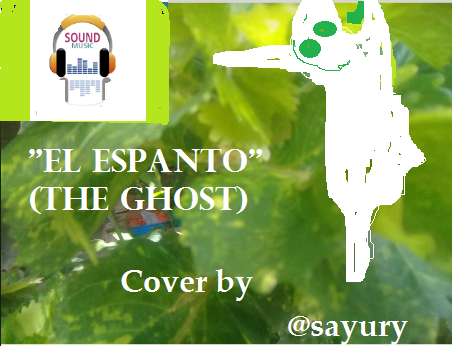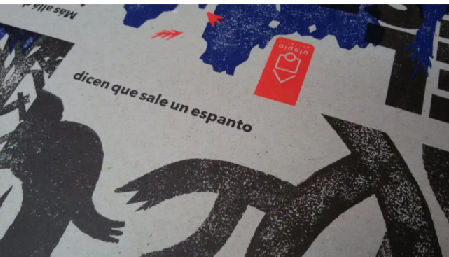"El espanto" (The ghost) Cover by @sayury
 )
)
Hola, comunidad de amantes de la música. Les traigo una canción del folclor venezolano, es un merengue larense, su letra es muy "chusca", graciosa. Su música es alegre y espero que la disfruten.
Cuando se reune un grupo de amigos a cantar y tocar o en cualquier celebración familiar donde alguien llegue "con un cuatro en la mano" es muy probable que sea esta una de las canciones que se interpreten después del consabido "Oye...¿Tú te sabes "El Espanto"?
Tenemos varios términos qué aclarar, y me pareció conveniente por ello preparar una especie de glosario que ayudará a comprender mejor la letra de la canción:
Espanto: Así se llama en Venezuela a los espectros o fantasmas y hay muchas leyendas acerca de dichos "muertos" o "aparecidos"
Pelaos (Pelados): Cuando se refiere a los ojos indica que están muy abiertos ("Ojos más abiertos que un vendedor de prendas " ( En este caso "prendas" son "joyas")
Chorriao (Chorreado): Enelcasode los bigotesse refiere a que son caídos, es decir,hacia abajo como si estuvieran colgando.
Paraos (Parados) Los pelos "paraos", es tener los cabellos levantados, hacia arriba, por no habérselos peinado
Carota (Caraota) Son unos granos de color negro muy frecuentes en la mesa del venezolano. No confundir con frijoles negros que son otros. Se dice que la caraota negra es como el blue jean...¡Combina con todo! De hecho, un plato típico como lo es el "pabellón" esta conformado por caraotas negras, arroza blanco, carne "esmechada" y tajadas de plátano
Ñema: Es la parte amarilla de los huevos, formados estos por clara y "ñema". Aunque a veces, por antonomasia, se refiere al huevo completo y se va a a comprar y se pide "Deme dos ñemas". Aunque hay quien en broma dice "Deme dos pollos enteros en su cáscara"
Tajá (Tajada). En Venezuela se cultiva el plátano, que es una especie de banana pero grande y que se come cortado en tajadas yfrito enaceite o manteca muycalientes, se sancocha para hacer puré quese come conmantequilla queso rallado. tambiénse puede cortr cada plátano en dos trozos que se abren enforma longitudinal, allí dentro se les coloca una rebanadita de queso y se hornean.
Esta canción "El Espanto"es letra y música de Adelis Freitez (Lara, 1943 – Barquisimeto, 2020), cofundador y director del grupo "Carota, Ñema y Tajá", docente en diversas universidades y quien recibió un doctorado honoris causa de la UNESR
Esta famosa y divertida canción se convirtió en el 2021 en un libro infantil ilustrado por Yonel Hernández. Fue publicado por el sello independiente Utopía {portátil}. Las ilustraciones fueron inspiradas tanto en el tema musical como en los paisajes del Parque Yakambú, del estado Lara, tierra del compositor

Fue popularizada por el grupo "Carota , ñema ytajá"
Otras versiones de este merengue larense:
: "Francisco Pacheco y su Pueblo",
"Quinteto Venezuela"
"Venezuelan Power"
"@carmenrivas"
Más allá de no sé donde
tampoco se sabe cuándo
Dicen que sale un espanto
Que lo vieron no se sabe
ni dónde, ni cómo, ni cuando
ni por qué andaba espantando
Yo lo vi, yo si lo vi
Yo lo vi, yo si lo vi
- Era un muerto sin cabeza
Sin pantalón, ni camisa
Con las manos en el bolsillo
Y una macabra sonrisa
Yo lo vi, yo si lo vi
Yo lo vi, yo si lo vi
Tenía los ojos pela'os
Tenía el bigote chorrea'o
Tenía los pelos para'os
Tenía la barba pa' trás
Y bailaba este merengue
Sabroso así de medio la'o
Y bailaba este merengue
Con ese ritmo atravesa'o
Fuente
Comparto con ustedes el video con la versión original de "Carota, ñema y tajá"

 )
)
Hello, community of music lovers. In this third round in week 105 of this wonderful Hive Music Festival I bring you a song from Venezuelan folklore, it is a Larense merengue, its lyrics are very funny. Its music is happy and I hope you enjoy it.
When a group of friends gets together to sing and play or at any family celebration where someone arrives "with a four (Kind of small four-string guitar) in their hand" it is very likely that this will be one of the songs that is performed after the well-known "Hey... Do you know "El Espanto"? (The Ghost)
We have several terms to clarify, and I thought it would be convenient to prepare a kind of glossary that will help better understand the lyrics of the song:
Espanto: This is what specters or ghosts are called in Venezuela and there are many legends about these "dead" or "appeared" ones.
Pelaos (Peeled): When referring to the eyes it indicates that they are very open ("Eyes more open than a garment seller" (In this case "garments" are "jewels")
Chorriao (Dripped): In the case of mustaches, it refers to the fact that they are drooping, that is, downward as if they were hanging.
Paraos (Parados) The hair "paraos" is having the hair raised, upwards, because it has not been combed.
Carota (Caraota) These are black beans that are very common on the Venezuelan table. It is said that the black bean is like blue jean...It goes with everything! In fact, a typical dish such as "pabellón" is made up of black beans, white rice, "smechada" meat and slices of banana.
---
Ñema: It is the yellow part of the eggs, made up of white and "nyema". Although sometimes, par excellence, it refers to the complete egg and you go to buy it and ask "Give me two ñemas." Although there are those who jokingly say "Give me two whole chickens in their shells"
Tajá (Tajada). In Venezuela, the plantain is grown, which is a type of banana but large and is eaten cut into slices and fried in very hot oil or butter. It is parboiled to make a puree that is eaten with butter and grated cheese. You can also cut each banana into two pieces that are opened longitudinally, place a slice of cheese inside and bake them.
This song "El Espanto" (The Ghost) is lyrics and music by Adelis Freitez (Lara, 1943 – Barquisimeto, 2020), co-founder and director of the group "Carota, Ñema y Tajá", teacher at various universities and who received an honorary doctorate from UNESR
This famous and fun song became a children's book illustrated by Yonel Hernández in 2021. It was published by the independent label Utopia {portable}. The illustrations were inspired by both the musical theme and the landscapes of Yakambú Park, in the state of Lara, the composer's land.

It was popularized by the group "Carota, ñema y tajá"
Other versions of this Larense meringue:
: "Francisco Pacheco and his People",
"Venezuela Quintet"
"Venezuelan Power"
"@carmenrivas"
Beyond I don't know where
It is not known when
They say a ghost comes out
Who saw it is not known
nor where, nor how, nor when
nor why was he frightening
I saw him, I did see him
I saw him, I did see him
He was a dead man without a head
No pants, no shirt
With his hands in his pocket
And a macabre smile
I saw him, I did see him
I saw him, I did see him
He had very open eyes
He had a dripping mustache
He had his hair disheveled
He had his beard behind him
And he danced this merengue
Tasty like this halfside
And he danced this merengue
With that rhythm blocking the way
I share with you the video with the original version of "Carota, ñema y tajá"

Own photos and video taken with Samsung J2 Prime cell phone
Fotos y video propios, tomadas con celular Samsung J2 Prime
The text in Spanish was created without AI
El texto en castellano fue creado sin IA
The text in English I translated it with / El texto en ingles lo traduje ayudándome con
Editing of both video and photos in Inshot and Paint
Las ediciones tanto del vídeo como de fotos en Inshot y Paint
If you want you may follow me on the networks
Si lo deseas puedes seguirme en las redes
▶️ 3Speak

"Please follow @hive.helps as he organizes donations for charity projects."
"Siga a @hive.helps mientras organiza donaciones para proyectos benéficos".

Thanks a lot for your support, @ladiesofhive.
https://m.youtube.com/watch?v=mqlw6Bk-leE&pp=ygUoRWwgZXNwYW50byAodGhlIGdob3N0KSBjb3ZlciBieSBAc2F5dXJ5IA%3D%3D
Este es el vídeo. En casa la luz va y viene y no.me deja editar el post
Este es el vídeo. La luz va y viene y no me permite editar el post